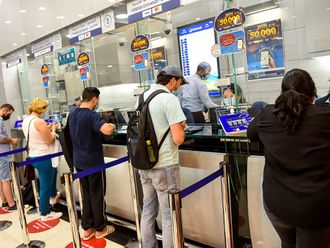_16a4f3f9cc0_medium.jpg)
With the recent rise of resale apps, the idea of selling old clothes online is becoming more fashionable. Many people have turned clothing resale into a lucrative side gig or even a full-time job, gaining thousands of followers on social media and making dozens of sales per week.
The second-hand clothing market is projected to more than triple by 2030, according to a study by reselling online platform Mercari and research firm GlobalData, as more fashion enthusiasts clean out their closets and search thrift stores to find valuable pieces to resell.
While The Luxury Closet is a consignment marketplace focused on the luxury segment, Melltoo is a mass-market re-commerce marketplace that facilitates transactions between individuals, never directly handling the products.
According to a survey by Statista.com, 50 per cent of millennials prefer the resale value of an item when purchasing luxury goods, to the actual cost. The growth in resale platforms globally has further enabled this trend. This is why start-ups in the space are set to grow as consumers further adopt the trend.
But whether you have a collection of band T-shirts or office attire, finding success on these platforms takes time and effort. Before diving into your closet, there are a few things to know.
You set your prices
Unlike consignment and resale shops, you can price items yourself on an online platform. Before listing a piece of clothing, look it up on multiple platforms to find out what it's currently selling for. Depending on age, condition and brand, prices can vary widely.
You can also take advantage of direct messaging to negotiate with buyers worldwide and use features on most of the up-and-coming apps that let you accept offers and create multi-item discounts.
“Sales can be sporadic,” says Andres Castillo, who sells rare designer pieces on social media under the name Debonair Vintage. With rare or high-value items, it may take a while to find the right buyer, especially if you're looking to break even or make a profit.

There's a big time commitment
“I treat (reselling clothes) like my job,'' said Eve Perez, a full-time Lebanon-based student, who sells under the name Fitsfinesse and was featured in Teen Vogue magazine in 2021 for her success. She responds to messages daily, on top of taking product photos, sewing custom pieces, and packaging and shipping orders.
Communicating clearly with first-time buyers is essential: “If you don't build that relationship, then you won't get sales and returning customers,” she added.
Although you have control over the prices, reselling online takes much more time and energy than selling to consignment stores. According to these global reselling applications, sellers who list consistently – around 15 items per week – sell more over time.
“It takes a lot of time and dedication,” said Castillo. Top-notch sellers have to learn to take eye-catching photos, understand shipping rates, negotiate over text, and research brands and trends to make the most of their inventory.
Overhead costs add up
Yes, you can set your prices – but there are a few overhead costs to factor in. Online resale platforms charge commission fees, plus additional fees for shipping through the platform or accepting payments through a processor.
Surveys show that when listing your products on such resale applications, the app takes about 10 per cent of every sale and other popular online selling platforms take 15 per cent. The higher the cost of the items you list, higher their cut. Additionally, payment processors charge another 3.5 per cent per transaction for processing your bill.
On top of that, you'll need to pay for packaging, label printing and possibly storing inventory including bins, hangers and shelves. Top sellers also recommend adding a personal touch in shipments, like free stickers, small accessories or a thank-you note. When all those costs add up, you may find that only higher-value items are worth listing.
You can cut costs by reusing shipping mailers and boxes, and printing labels at your local courier service instead of purchasing a label printer. Or, reduce shipping costs for buyers by bundling several items into a single shipment, which can motivate buyers to purchase more from your shop.

The social aspect is a priority
The most successful online resellers have one thing in common: a strong personal brand. Finding your niche and building a loyal following is essential to long-term success on a resale platform.
“It's like Instagram, but for selling,” said Perez, who focuses on curating a consistent aesthetic and marketing her shop on social media platforms like TikTok.
Castillo grew his business by catering to a very specific market: vintage designer collectors, specifically for global luxury retail brands like Moschino and Chanel. He sells across several platforms, using his social media account to rent pieces out to stylists for photo shoots and red-carpet events. Though he targets a fairly small community, his narrow focus helps him reach his ideal buyers.
Other top sellers on resale platforms can be seen taking a similar approach, with shop themes ranging from band T-shirts to vintage gowns. `”Lean into your personal taste,” added Castillo. Even if you don't have a curated collection to sell, personalised packaging or a unique photo background can help your items stand out.
Both Perez and Castillo emphasise the importance of cross-linking social media platforms to reach as many potential customers as possible. Creating a dedicated business account on social media and following other online sellers and designers can help drive buyers to your shop. Check popular pages for trendy hashtags and add those to your posts. Making the time to promote on social media can help transform your closet into some serious income.








_resources1_16a4a1613d8_small.jpg)



